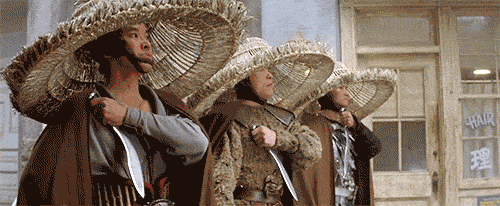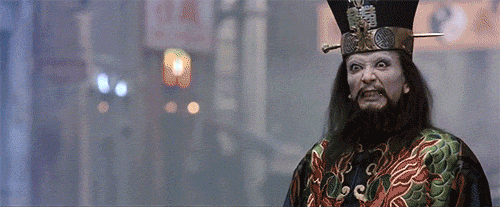Summer of '86: The Wild, Wacko Genre Mashup of 'Big Trouble in Little China'

All this week, we’re celebrating the great movies that hit screens 30 years ago in 1986. Go here to read more.
Big Trouble in Little China was an unqualified bomb when it debuted in July 1986. Despite boasting the biggest budget ($20 million) of Halloween and The Thing director John Carpenter’s career, the film only earned a paltry $11 million. Nonetheless, like quite a few of Carpenter’s subsequent works (1987’s Prince of Darkness, 1988’s They Live, 1994’s In the Mouth of Madness), the unique, even bizarre, film has gone on to earn a fervent cult following — in large part because, 30 years after its release, it continues to be one of the first and finest mash-ups of American and Asian cinema.
Big Trouble in Little China recounts the epic adventures of Jack Burton (Kurt Russell), a cocksure truck driver who winds up in supernatural San Francisco trouble while trying to help Chinatown restaurateur and friend Wang Chi (Dennis Dun) rescue his girlfriend Miao Yin (Suzee Pai) from the clutches of David Lo Pan (James Hong), a mysterious businessman who, it turns out, is actually an ancient sorcerer intent on achieving ever-lasting life. Jack and Wang descend into the bowels of a Chinatown where gang warfare is rampant, paranormal enemies are legion — including Lo Pan’s trio of straw-hatted elemental warriors Thunder (Carter Wong), Rain (Peter Kwong), and Lightning (James Pax) — and where Jack’s feisty love interest, social worker Gracie Law (Kim Cattrall), soon becomes a damsel in need of rescue.

That legitimately loony set-up leads to all manner of out-there insanity, which some critics thought was excessive. Roger Ebert, for one, opined, “Carpenter has allowed technology to dominate his story…. Special effects don’t mean much unless we care about the characters who are surrounded by them, and in this movie the characters often seem to exist only to fill up the foregrounds.” And there’s no doubt the film often trades in broad Asian stereotypes (Victor Wong’s super-powered old sage Egg Shen; Hong’s evil, cackling sorcerer Lo Pan; Donald Li’s goofy colleague Eddie Lee) — a facet that Ebert himself noted in his mostly negative review, writing, “This movie is straight out of the era of Charlie Chan and Fu Manchu, with no apologies.”
Related: Summer of ’86: ‘Ferris Bueller’s Day Off’ Let John Hughes Graduate from Teen Movies With Honors
Still, considering the fact that actors of Chinese, Korean, or Japanese descent rarely headline Hollywood movies even today, Big Trouble is all the more remarkable for the prominence of its Asian players. The de facto star of the show is Russell’s hilarious Burton, a blustery buffoon whose confidence is as unwavering as his come-ons are corny. Yet in a sly, subversive twist, Burton (who Russell embodies as an absurd John Wayne) does little more than fall ass-backwards into triumph, all while his nominal sidekick Wang repeatedly saves the day. Wang is this story’s capable, kick-ass hero, and as such, the film plays like a battle between Asian good guys and villains, with the mulleted, macho Burton relegated to featured clown duty.

The material’s off-the-wall campy tone was the byproduct of a major pre-production re-write, as co-screenwriter Gary Goldman tells Yahoo Movies in a recent interview. Inspired by 1979’s Tsui Hark classic The Butterfly Murders, scribes Goldman and David Z. Weinstein immersed themselves in Asian cinema and set their own tale in turn-of-the-century San Francisco during Tong Wars. Once sold, Goldman and Weinstein’s initial treatment was extensively updated by W.D. Richter (The Adventures of Buckaroo Banzai Across the 8th Dimension) to take place in the present day, and to imbue it with its now-trademark jokiness. Still, while the film’s attitude was radically transformed, Goldman asserts that, “moment by moment, scene by scene, dramatic beat by dramatic beat, everything was retained.“ In a 2001 conversation with Ain’t It Cool News, Carpenter more or less corroborated Goldman’s assessment of the rewrite, saying, “Rick [Richter] came in and made it a comedy and up to date. He changed some of the scenes, but it’s basically the same.”
Goldman says that he and partner Weinstein never gave much thought to the notion that they were breaking new ground by providing Asian-Americans with leading roles. “I really don’t think that entered our mind,” he says. “The idea that the Asian element would be a deterrent wasn’t really something we considered. We wanted to tell our story, and this was the only way to do it.” Last April, at a cast reunion held at Los Angeles’ Japanese American National Museum, co-star Peter Kwong (who played “Rain”) remarked that, coming right after 1985’s Year of the Dragon — a Michael Cimino-helmed noir that was criticized for its negative portrayal of Asian-Americans — Big Trouble in Little China went out of its way to make sure that it didn’t fall into a similar trap. “Not only did it represent fun and games, but it represented a critical point of where the community met Hollywood,” Kwong said. “John Carpenter was really amazing because he really reached out to cast and crew. He really asked for all of us to put in our input.”
For his part, Goldman says that combining East and West was something that was “in the air” by 1986. “We were bringing together Chinese culture and American culture into one dish.” The film’s larger-than-life, almost cartoonish characterizations are completely in tune with its crazed blending of disparate old/new, East/West elements. Big Trouble’s fundamental hybrid nature makes it a precursor to the likes of The Matrix and its descendants, which similarly embraced Asian cinema’s swift wirework action, heady mysticism and fantasy, and chosen-one-makes-good narratives.
It remains up for debate whether Big Trouble in Little China’s bummer box office was due to its ahead-of-its-time mash-up or simply because it was weirder than audiences expected. Yet its current home video-fostered cult classic status is beyond dispute: The film now boasts an 84 percent rating on Rotten Tomatoes, and plans are underway for a remake starring Dwayne “The Rock” Johnson. Unlike so many of its formulaic summer movie predecessors, Carpenter’s film embraces conventions and then smashes them together in wild and wacko ways in order to produce something eccentrically new.
Watch a trailer:
Read more:
Summer of ’86: ‘Stand by Me’ Takes on Life, Death, and One Epic Barf-o-Rama
Summer of ’86: The Terrifying Madness of ‘Manhunter’ — and Our First Introduction to an Infamous Serial Killer
Summer of ’86: ‘Ferris Bueller’s Day Off’ Let John Hughes Graduate from Teen Movies With Honors